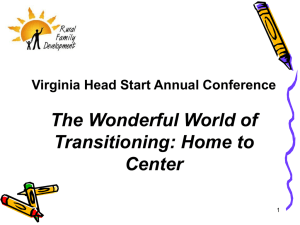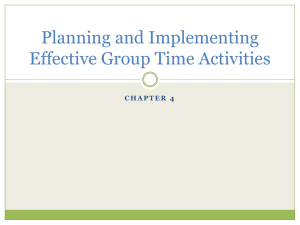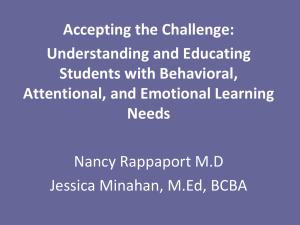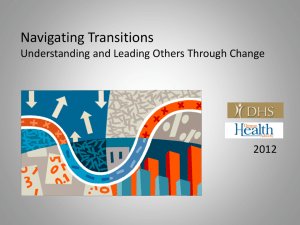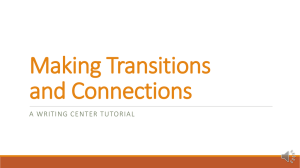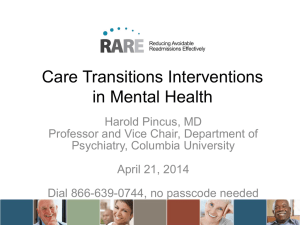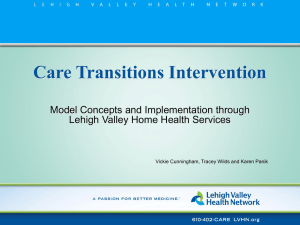March 13, 2011 - Center for Technology and Aging
advertisement
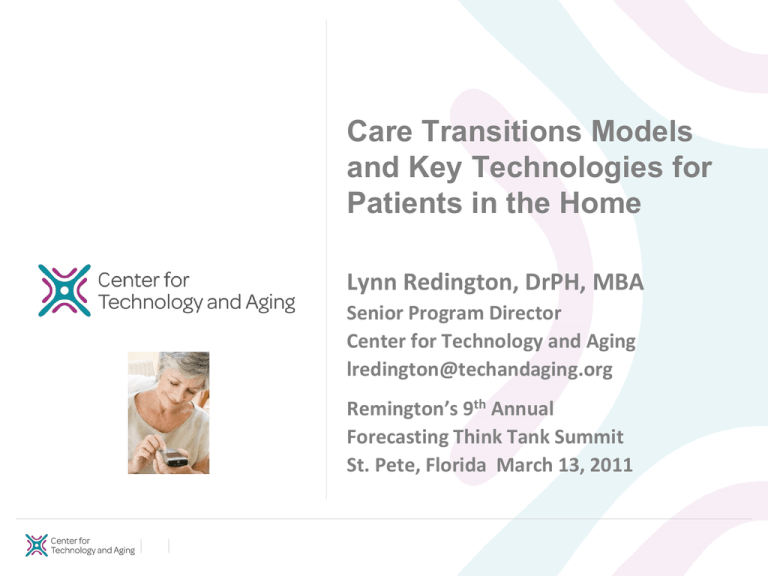
Care Transitions Models and Key Technologies for Patients in the Home Lynn Redington, DrPH, MBA Senior Program Director Center for Technology and Aging lredington@techandaging.org Remington’s 9th Annual Forecasting Think Tank Summit St. Pete, Florida March 13, 2011 Center for Technology and Aging Established in 2009 with funding from The SCAN Foundation, located at the Public Health Institute Mission: Expand the use of technologies that help older adults lead healthier lives and maintain independence Independent, non-profit resource center on issues related to diffusion of technology for older adults Technology Diffusion Grants Programs e.g., Tech4Impact grant (Technologies for Improving Post-Acute Care Transitions “Tech4Impact”) Post-Acute Care Transitions & Re-admissions • Avoidable Readmissions: Opportunity for better care, better health, lower costs 1 in 5 patients readmitted within 30 days of discharge 76% of readmissions are preventable A $25 billion savings potential • Call to action: Improve care transitions (e.g., hospital to home) Improve care coordination, outreach, patient engagement and support References: New England Journal of Medicine, Jencks S, et al “Rehospitalizations among patients in the Medicare fee-for-service program” N England Journal of Medicine 2009; 360: 1418-28. PricewaterhouseCoopers, 2008. The price of excess: Identifying waste in healthcare spending. Many QI opportunities to reduce hospitalization . . . Care Transitions Models Improve Processes, Information Flows, and Capacity • Evidence-based models include: • Care Transitions Intervention • Transitional Care Model • Guided Care • GRACE • Others The Care Transitions Intervention (CTI) • “The Coleman Model” • Qualifications: CTI Coach can be layperson • Length of intervention: 30 days • Average cost: $196 per patient • Steps: • Four pillars--Medication management; Patient-centered record; Follow-up; Red flags • Five encounters--Hospital/SNF Visit; Home Visit; 3 Follow-Up Calls Transitional Care Model (TCM) • “The Naylor Model” • Qualifications: Transitional Care Nurses are advanced practice nurses (BA-prepared nurses under study) • Length of intervention: 1 to 3 months • Average cost: $982 per patient • Steps: • Visit patient in hospital, home visit w/24 hours, accompany patient to 1st doctor visit, facilitate clinician collaboration and communications with patient/family, on call 7 days a week Guided Care • Developed at Johns Hopkins University since 2001 • Qualifications: Guided Care Nurse must be an RN • Length of intervention: For life • Average cost: $1743 per patient per year • Steps: • Conduct comprehensive home assessment, create care guide and action plan for patient, provide monthly monitoring and selfmanagement coaching, coordinate care, facilitate access to community services, engage/educate informal caregivers GRACE: Geriatric Resources for Assessment and Care of Elders • “The Counsell Model” • Qualifications: Nurse practitioner and social worker • Length of intervention: Long term/indefinite • Average cost: $1432 per patient per year • Steps: • In-home assessment, home visit after any hospitalization, one phone or in-person follow-up per month, collaborate with PCP, hospital discharge planner and others in a team-based approach How Technologies May Support Care Processes Video-Based Telemedicine Education Smart Sensors Wireless Broadband Networks Remote Patient Monitoring Home Medication Management Patient Health Records Technology Usage Examples: CTA Grantees that Aim to Reduce Hospitalizations Medication Optimization Technologies •American Society of Consultant Pharmacists Foundation •Caring Choices •Connecticut Pharmacists Foundation •VA Central California Health Care System •Visiting Nurse Services of New York Personal Health Records Technologies State Units on Aging and ADRCs in: •California •Rhode Island •Washington Remote Patient Monitoring Technologies •AltaMed Health Services, Stamford Hospital •California Association of Health Services at Home •Centura Health at Home •New England Healthcare Institute •Sharp HealthCare Foundation •HealthCare Partners •Catholic Healthcare West Evidence-Based Care Transitions QI Evaluation Technologies State Units on Aging and ADRCs in: •Indiana •Texas ADRC = Aging and Disability Resource Center Veterans Health Administration (Central CA) CTA Grant Project Focus Area Medication Adherence, Remote Patient Monitoring (RPM) Population Vets with CHF, hospitalized within past 1-2 years Technology In-home RPM appliance using POTS, Med Adherence Algorithm, weight scale, BP cuff Expected Benefits Reduce hospital/ED visits; improve patient activation, QOL & satisfaction Workforce Issues Care coordinator (RN), MD oversight, Automated clinician alerts, enabled patients/informal caregivers Organizational Readiness VHA: world’s largest telehealth user, rural health = telehealth (see next 2 slides for background) POTS = Plain Old Telephone Service The Early Adopter Experience: Veterans Health Administration (1 of 2) • • • VHA has evaluated, piloted, reevaluated, and deployed telehealth technologies in a continuing process of learning and improvement far beyond adoption in the private sector Largest national program--enables detailed analyses Home telehealth compared to traditional care models: – Studies conducted on patients enrolled in the VA’s Care Coordination/Home Telehealth program in 2006 and 2007 show: • 25% reduction in bed days of care • 20% reduction in numbers of admissions • 86% mean satisfaction score rating The Early Adopter Experience: Veterans Health Administration (2 of 2) Net cost = $1,600 / patient / year vs. Age Distribution of all CCHT Patients • VHA’s home-based primary care services = $13,121 / patient / year • Market nursing home care rates average = $77,745 / patient / year VHA takes “systems approach” to integrate the elements of the CC/HT program. This includes: • Product selection • Training • Protocols for patient selection, management • Data analytics Since VHA implemented CCHT in 2003, a total of 43,430 patients have been enrolled Indiana State Unit on Aging CTA Grant Project Focus Area Implementing GRACE care transitions model and technologies into VAMC Indianapolis Population Older Vets at high risk for hospitalization and institutional care Technology Technologies that support GRACE protocols (EHR, automated prompts, Web-access to protocols and other tools) Expected Benefits improved performance on Assessing Care of Vulnerable Elders (ACOVE) quality indicators, higher satisfaction, and decreased hospital readmissions and long-term institutionalization Workforce Issues Team-based approach coordinated by GRACE-trained nurse practitioner and social worker, increased engagement of patients and caregivers, local ADRC integrated into process Organizational Readiness VA validates new innovations before taking nationwide; GRACE intervention originated in Indiana; Counsell is leading project Washington State Unit on Aging CTA Grant Project Focus Area Improving communications, coordination, self-management during care transitions Population Patients recently discharged from hospital that are participating in the Care Transitions Intervention program Technology EHRs and PHRs (Electronic Health Records, Personal Health Records) Expected Benefits Reduce hospitalizations/re-hospitalizations, improve patient selfmanagement, improve communications Workforce Issues CTI coach, connected clinicians, increased engagement of patients and caregivers Organizational Readiness An early adopter, Whatcom County, WA started project in 2001 Connecticut Pharmacists Foundation CTA Grant Project Focus Area Remote Medication Therapy Management Population Older Cambodian-Americans w/ history of torture/trauma, high incidence of chronic illness and low literacy rate Technology Video conferencing, spoken format technology, EMR Expected Benefits Reduce hospital/ED visits; improve meds use; improve access to culturally concordant providers Workforce Issues Remote pharmacist visit, patient is accompanied by community health worker. Few providers trained in special needs of this population. Organizational Readiness Connecticut partner, Khmer Health Advocates, is the only Cambodian health organization in the US Diffusion of Innovations Lessons Learned •Stakeholder readiness to adopt •Business model/payment model •Technology/Intervention model • Evidence base/relative advantage • Compatibility • Complexity •Policy issues Center for Technology and Aging www.techandaging.org

